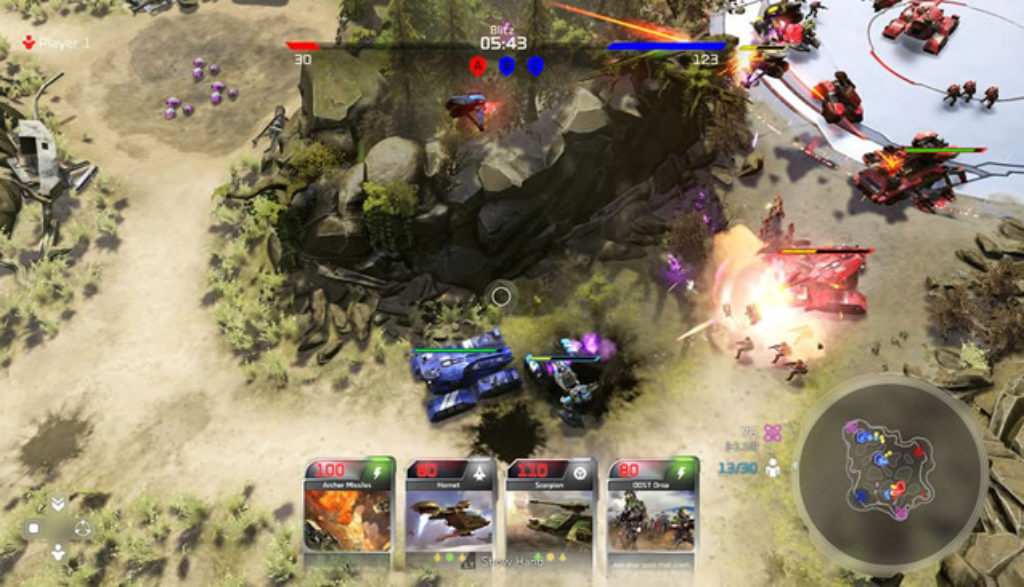
Halo is taking aim at your family room once again.
Now, if you’re wondering if you’ll need to catch up on all the many past Halo adventures and storylines in order to figure out exactly what’s going on this time around, let me say you don’t have to worry about that. This game follows a sort of parallel storyline. So, while it’s all related, there aren’t any Master Chief-and-the-fate-of-humanity elements here. It’s more of a straightforward sci-fi war story.
Oh, and there’s no first-person trigger-pulling and up-close purple-goopy gore to worry about in this mix either. Like 2009s Halo Wars, this T-rated, real-time strategy contest puts you charge of commanding little groups of troops and vehicles from on high.
OK, so what do we encounter in Halo Wars 2?
The game’s storyline picks up several decades after the first Halo Wars title. The Spirit of Fire, a UNSC warship, has been adrift for 28 years with its crew in cryosleep. Stalwart Captain James Cutter and crewmates awaken to find that a couple trouble events have transpired during their long hibernation.
For one thing, they’ve drifted into uncharted space while the ship’s AI was repairing all the shipboard damage from their last major conflict. And they’re now outside an alien installation dubbed the Ark. There aren’t any Covenant alien armies to fear any longer. Those beings have been vanquished and replaced by something, well, even worse. It seems a former Covenant Brute named Atriox has led an uprising of other Covenant exiles.
Together they’ve formed a fearsome and growing enemy force called The Banished. These massive and brutally powerful warriors attacked the Ark and unlocked the Covenant’s arsenal of terrible weapons. They’re now determined to destroy anything in their path. And, of course, that includes the outgunned, undermanned and nearly antique Spirit of Fire.
When you plunge into actual gameplay, it becomes a balancing act of supply and power. Planetside targets must be captured, bases must be defended and waves of attacking enemies must be endured and outmaneuvered.
As was the case in Halo Wars, you have the job of constructing human bases. Doing so involves such things as supply pads (speeding the flow of materiel to the front), reactors (for raising your power levels), field armories (facilitating upgrades for better weapons), barracks (for training your troops), vehicle depots (factories for building all-purpose vehicles and anti-vehicle, anti-aircraft artillery) and flight pads (for creating light and heavy planes).
As these structures churn out troops, tanks and airships, you order them into action, watching from a bird’s-eye view and pinpointing where they must charge forth on the battlefield. In simpler terms: You figure out how to best build up your forces, then tell them where to go in order to blow other things up.
The advantage of that kind of from-a-distance war play is that you get all the chess-like joy of outmaneuvering and besting the massive scream-and-growl alien foes without having to duck bullets or wallow in the gore that you’d normally encounter in many M-rated, first-person shooters.
In fact, the messiest bits here are only seen in the story cutscenes as the huge Banished beasties pummel and blaze away at humans, and some Spartans shoot and stab back. (Words such as “a–” and “b–ch” occasionally pop up in the dialogue, too.)
But even there, bloodletting is kept to a minimum. The result is a Halo title that might not ultimately be kinder, but is definitely cleaner.

After spending more than two decades touring, directing, writing and producing for Christian theater and radio (most recently for Adventures in Odyssey, which he still contributes to), Bob joined the Plugged In staff to help us focus more heavily on video games. He is also one of our primary movie reviewers.